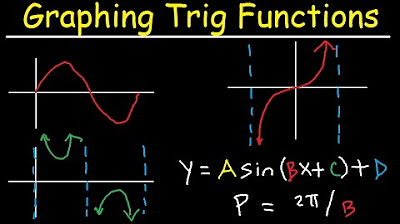How do you determine the phase shifts for sine and cosine graphs
TLDRThis educational video script delves into the concept of phase shifts in trigonometric functions, drawing parallels with quadratic transformations. It explains how horizontal shifts in quadratic functions translate to phase shifts in sine and cosine functions, emphasizing the role of 'c' in the argument of the trigonometric function. The script clarifies that subtracting 'c' results in a rightward shift, while adding 'c' shifts the graph to the left. It also highlights the importance of understanding the period of trigonometric functions and how it impacts phase shifts. The instructor illustrates the process of determining phase shifts by setting the argument of the function equal to zero, providing clear examples to demonstrate shifts to the right and left.
Takeaways
- 📚 Phase shifts are a concept used to understand how graphs of functions can be moved left or right.
- 📈 The concept of phase shifts is analogous to horizontal shifts in other functions, such as quadratics.
- 🔄 Horizontal shifts to the right occur when the function has a form like y = f(x - c), and to the left when it's y = f(x + c).
- 📉 In the context of trigonometry, phase shifts are particularly relevant for sine and cosine functions.
- 🌀 The standard form of a trigonometric function that includes phase shift is y = a ⋅ sin(bx - c) + d or y = a ⋅ cos(bx - c) + d.
- ➡️ A negative value of 'c' in the argument of sine or cosine indicates a rightward shift, while a positive 'c' indicates a leftward shift.
- 🔄 The direction of the shift is opposite to the sign of 'c' due to the subtraction in the function's argument.
- 🔢 The amount of phase shift is determined by setting the argument of the sine or cosine function equal to zero and solving for 'x'.
- 🔁 Trigonometric functions are cyclical with a period that affects how phase shifts are calculated.
- 📏 The period of a trigonometric function is related to the value of 'b' in the function and influences the distance over which the function repeats.
- 📊 To find the phase shift, one must consider the initial period of the function and where the graph starts and ends within that period.
Q & A
What is a phase shift in the context of trigonometric functions?
-A phase shift in trigonometric functions refers to the horizontal movement of the function's graph to the left or right. It is determined by the value inside the function's argument and affects when the function starts its cycle.
How do horizontal shifts of a graph relate to phase shifts?
-Horizontal shifts of a graph are similar to phase shifts in that they both involve moving the graph left or right. However, phase shifts specifically apply to trigonometric functions and are influenced by the periodic nature of these functions.
What is the standard form of a quadratic function and how does it relate to phase shifts?
-The standard form of a quadratic function is y = a(x - h)^2 + k. It relates to phase shifts because the term (x - h) shows how the graph is shifted horizontally, which is analogous to the phase shift in trigonometric functions.
Why is it important to understand the direction of the shift in trigonometric functions?
-Understanding the direction of the shift is crucial because it determines whether the graph moves to the left or right. A positive value inside the function's argument results in a leftward shift, while a negative value causes a rightward shift.
What is the general form of a sine function that includes a phase shift?
-The general form of a sine function that includes a phase shift is y = a * sin(b * (x - c)) + d, where 'c' represents the phase shift.
How does the value of 'c' in the sine function affect the phase shift?
-The value of 'c' in the sine function determines the direction and magnitude of the phase shift. A positive 'c' results in a leftward shift by 'c' units, while a negative 'c' results in a rightward shift by the absolute value of 'c' units.
What is the significance of the period in trigonometric functions?
-The period of a trigonometric function is the length of one complete cycle before the function begins to repeat itself. It affects the phase shift by determining how far the function must be shifted to complete one revolution.
How is the period of a trigonometric function determined?
-The period of a trigonometric function is determined by the value of 'b' in the function's argument. For example, the period is 2π divided by the absolute value of 'b'.
What is the initial period of a sine or cosine function, and why is it important?
-The initial period of a sine or cosine function is the first complete cycle that can be graphed, starting and ending at 0 and 2π, respectively. It is important because it helps in determining the phase shift and understanding where the function starts and ends.
How can you find the phase shift of a given trigonometric function?
-To find the phase shift of a given trigonometric function, set the expression inside the function's argument equal to zero and solve for 'x'. The value obtained will indicate the phase shift in terms of the direction and magnitude.
Can you provide an example of how to calculate the phase shift for the function y = sin(πx + π)?
-To calculate the phase shift for y = sin(πx + π), set the expression inside the sine function equal to zero: πx + π = 0. Solving for 'x' gives x = -1, indicating a phase shift of one unit to the left.
Outlines
📚 Introduction to Phase Shifts and Graph Transformations
The video script begins with an introduction to phase shifts, using the context of graph transformations for functions, which is a concept from algebra. The instructor uses the example of a standard quadratic function, y = x^2, to explain horizontal shifts by modifying the function to y = (x - 2)^2 and y = (x + 1)^2, demonstrating how the graph shifts to the right. The concept of vertical shifts is mentioned but not the focus. The instructor then transitions to discussing phase shifts specifically in the context of trigonometric functions, comparing them to the quadratic function's form, y = a(x - h)^2 + k, to illustrate the relationship between the function's form and the direction of the shift. The standard form of sine and cosine functions, y = a*sin(bx - c) + d and y = a*cosine(bx - c) + d, is introduced, emphasizing the role of 'c' in determining the direction of the phase shift.
🔍 Understanding Phase Shifts in Trigonometric Functions
In the second paragraph, the focus shifts to understanding phase shifts in the context of sine and cosine functions. The instructor explains that phase shifts involve moving the graph left or right and that this is influenced by the value of 'c' in the function's equation. A general equation, y = sine(x - π), is used to illustrate a rightward shift of π units. The instructor then contrasts this with the cosine function, using the example of πx + π, to demonstrate a leftward shift, highlighting the cyclical nature of trigonometric functions and the importance of the period in phase shifts. The period is shown to be dependent on the value of 'b' in the function, and the instructor explains how to calculate the phase shift by setting the expression inside the function equal to zero, which determines the new starting point of the graph. The example of πx + π is revisited to show that the graph starts at x = -1, indicating a phase shift of one unit to the left. The summary concludes with a clear definition of phase shift for sine and cosine graphs.
Mindmap
Keywords
💡Phase Shift
💡Trigonometry
💡Quadratic Function
💡Transformations
💡Horizontal Shifts
💡Standard Form
💡Cyclical Functions
💡Period
💡Sine Function
💡Cosine Function
Highlights
Introduction to phase shifts in the context of function transformations.
Relevance of phase shifts in trigonometry and real-world applications.
Comparison of phase shifts with quadratic function transformations.
Example of horizontal shifts using the equation y = (x - 2)^2.
Explanation of the standard form of a quadratic: y = a(x - h)^2 + k.
Introduction to the concept of phase shift in trigonometric functions.
Standard form of sine and cosine functions and their relation to phase shifts.
Impact of subtracted numbers (-c) on shifting graphs to the right.
Explanation of how positive c values result in shifting graphs to the left.
General equation example: y = sine(x - π) and its phase shift implications.
Clarification on the cyclical nature of trigonometric functions and their periods.
Importance of the period in determining phase shifts in trigonometric functions.
Demonstration of how to find the phase shift using the initial period.
Method to determine the phase shift by setting the function inside equals to zero.
Example using the cosine function to illustrate a phase shift to the left.
Final summary of phase shift definitions for sine and cosine graphs.
Transcripts
Browse More Related Video

How to Graph Phase Shifts of Trigonometric Functions (Precalculus - Trigonometry 16)

Graphing Transformations with Sine and Cosine (Precalculus - Trigonometry 12)

Graphing Trigonometric Functions, Phase Shift, Period, Transformations, Tangent, Cosecant, Cosine

AP Precalculus Practice Exam Question 20

Using Sum and Difference Formulas in Trigonometry (Precalculus - Trigonometry 26)

How To Graph Trigonometric Functions | Trigonometry
5.0 / 5 (0 votes)
Thanks for rating: